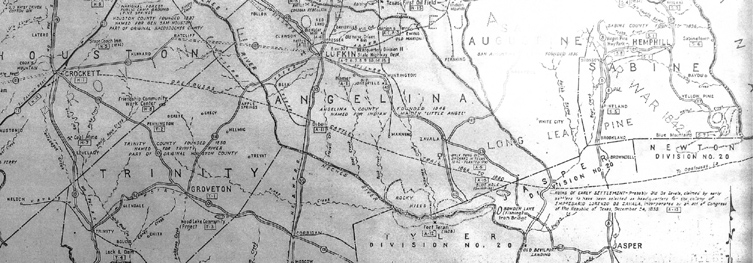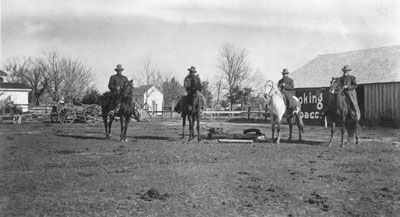The Opelousas Trail
By Jeff Campbell
"Come along boys and listen to my tale, I'll tell you of my troubles on the Old Chisholm Trail." The Chisholm Trail, along with the Shawnee, Goodnight-Loving and Western trails have become legendary pieces in the tapestry of American history. These northern bound, Texas cattle trails have been immortalized in songs, stories, books and movies.
After the Civil War until the late 1880's these four cattle trails drove Texas longhorns north to railroad towns in Colorado, Kansas, Wyoming, Nebraska and Missouri. However, long before Charles Goodnight and others began their legendary drives, another cattle trail had been in existence for almost a century.
The Opelousas Trail began in San Antonio, Texas and finished up in New Orleans, bringing beef to the Crescent City. "It was along or parallel to the Old Spanish Trail. The first recorded cattle drive along the Opelousas Trail occurred when "Francisco Garcia left San Antonio in 1779 with 2,000 steers bound for New Orleans" (Beaumont Enterprise, 1975)". There is some confusion of the exact route of the Opelousas, who some referred to as the "Beef Trail". Most Historians write this up to the probability that the Opelousas was a network of trails across East Texas.
One of the first Anglo-Saxons ranchers to drive cattle along the Opelousas trail was James Taylor White, starting in the 1820's. Soon more ranchers, from around Stephen F. Austin's colony on the Brazos, were droving on the Opelousas Trail. By the next decade Mr. White counted three thousand head of cattle in his herd and by the 1840's his herd had increased to 10,000 head of cattle. By this time his herd was comprised mostly of domestic cattle. However there were also thousands of wild Spanish cattle in south Texas. Whenever White's cowboys could place a brand on one it then became part of the White herd.
The biggest challenge facing an Opelousas cattle drive was the Neches River. "The cows stuck in front of me now are a reminder of the hazards of crossing water. So many cattle drowned on the Opelousas Trail that the town of Beaumont, Texas, where the Neches River wanders along the county line, enacted the "Ordinance to Prevent Nuisances by Swimming Cattle" in August of 1840. The provision levied a $ fine per drowned cow and a $50 bond before crossing. Drowning wasn't the only peril along this drive; there were also the thick humidity, heat, monsoons, robbers, and loneliness. It's a wonder White and his contemporaries ever made it to New Orleans at all. But the journey must have been worth it, because White's longhorn cattle, healthy and sleek from their marsh diets, made him one of the wealthiest men in Texas." Other dangers met the drovers as they moved cattle into Louisiana; swamps, bayous, snakes and alligators had to be dealt with along the trail.
Like the northern bound cattle trails, the Opelousas had its heyday in the reconstruction years after the Civil War. In the years after the war cattle that could be bought for $3.00 a head in Texas, could be sold to the U.S. Army in New Orleans for $30.00 a head. Some of the more famous drovers and ranchers of this time were Shanghai Pierce, Allen Coward (both from Texas) and C.T. Cade (of Louisiana).
The use of the Opelousas Trail as a viable transport for cattle was curtailed by the same force that ended the other trails, the Iron Horse. After the Civil War there were many small railroads throughout Texas and Louisiana; the Texas and New Orleans, the Louisiana Western, the Galveston, the Harrisburg and San Antonio Railway Company. In 1881C.P. Huntington, acting agent for the Southern Pacific Railroad Company, acquired these small railroads for the Southern Pacific Railroad. When the Southern Pacific completed a rail line across West Texas in 1881 they controlled a series of railroad lines from New Orleans to San Francisco. The railroads allowed for a quicker more efficient way of transporting cattle. Thus bringing an end to the Opelousas cattle drives.
Compared to its northern bound counterparts, not much has been shared about the Opelousas in story and song. So for the poets, pickers, playwrights and raconteurs, looking for new material about the old west, remember the "Opelousas"!

The Opelousas Trail through Angelina County. Credit - http://www.burketexas.com/

Richard, Green and George Washington Butler, worked cattle for their childless uncle, Allen Coward. The young brothers made cattle drives on the Opelousas Trail from Galveston County to New Orleans before the Civil War. Credit-City of League City
References
http://mikekearbystexas.blogspot.com/2011/05/trailing-cattle-short-history-part-2.html
http://www.wtblock.com/wtblockjr/opelousa.htm
Jim Keen, Great Ranches of the West KM Media, Inc.; 1 edition (July 9, 2007)